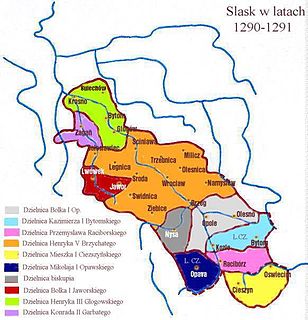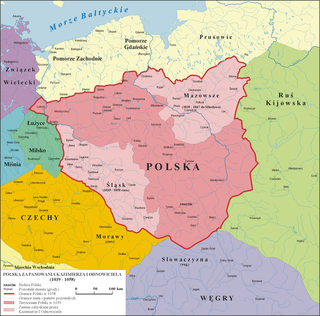Boleslaus II may refer to:

Przemysł I, a member of the Piast dynasty, was Duke of Greater Poland from 1239 until his death, from 1241 with his brother Bolesław the Pious as co-ruler. He was able to re-acquire large parts of Greater Poland, ruling as Duke of Poznań and Gniezno from 1247 and, upon several inheritance conflicts with his brother, as Duke of Poznań and Kalisz from 1249, sole Duke of Greater Poland from 1250, and Duke of Poznań from 1253 until his death.
Bolesław the Pious was a Duke of Greater Poland during 1239–1247, Duke of Kalisz during 1247–1249, Duke of Gniezno during 1249–1250, Duke of Gniezno-Kalisz during 1253–1257, Duke of whole Greater Poland and Poznań during 1257–1273, in 1261 ruler over Ląd, regent of the Duchies of Mazovia, Płock and Czersk during 1262–1264, ruler over Bydgoszcz during 1268–1273, Duke of Inowrocław during 1271–1273, and Duke of Gniezno-Kalisz from 1273 until his death.

The Duchy of Silesia with its capital at Wrocław was a medieval duchy located in the historic Silesian region of Poland. Soon after it was formed under the Piast dynasty in 1138, it fragmented into various Silesian duchies. In 1327, the remaining Duchy of Wrocław as well as most other duchies ruled by the Silesian Piasts passed to the Kingdom of Bohemia as Duchies of Silesia. The acquisition was completed when King Casimir III the Great of Poland renounced his rights to Silesia in the 1335 Treaty of Trentschin.
Bolesław II the Horned, known also as Bolesław II the Bald, a member of the Silesian Piasts, was High Duke of Poland briefly in 1241 and Duke of Silesia at Wrocław from 1241 until 1248, when the duchy was divided between him and his brothers. After the partition, he ruled the Silesian Duchy of Legnica until his death. The second Mongol raid against Poland, led by Nogai Khan, occurred during his reign.

Gertrude-Olisava, princess of Poland, was the daughter of King Mieszko II of Poland and Queen Richeza of Lotharingia, and the great-granddaughter of German Emperor Otto II.

Henry III the White, a member of the Silesian Piasts, was Duke of Silesia at Wrocław from 1248 until his death, as co-ruler with his brother Władysław.

Anne of Bohemia, a member of the Přemyslid dynasty, was Duchess of Silesia and High Duchess of Poland from 1238 to 1241, by her marriage to the Piast ruler Henry II the Pious. She was celebrated by the community of Franciscan nuns at St Clara of Prague Abbey in Wrocław as their founder and patron.

Judith of Bohemia, also known as Judith Přemyslid, was a member of the Přemyslid dynasty and duchess of Poland by marriage. She was a daughter of Duke Vratislaus II of Bohemia and Adelaide of Hungary, and was married to Władysław Herman.
Henry III of Głogów was a duke of Glogów from 1274 to his death and also duke of parts of Greater Poland during 1306–1310.

The Duchy of Legnica or Duchy of Liegnitz was one of the Duchies of Silesia. Its capital was Legnica (Liegnitz) in Lower Silesia.

Henry V the Fat was a Duke of Jawor (Jauer) from 1273, of Legnica (Liegnitz) from 1278, and Duke of Wrocław (Breslau) from 1290.

Konrad I of Oleśnica was a Duke of Żagań and Ścinawa during 1309–1312, Duke of Oleśnica, Namysłów, Gniezno and Kalisz during 1312–1313, Duke of Kalisz during 1313–1314 (alone), Duke of Namysłów from 1313 (alone) and Duke of Oleśnica from 1321 until his death (alone).

Bernard (II) of Świdnica was a Duke of Jawor-Lwówek-Świdnica-Ziębice between 1301–1312, of Świdnica-Ziębice during 1312–1322, and the sole Duke of Świdnica from 1322 until his death.
Salome of Greater Poland also known as Salomea Odonicówna, was a Polish princess member of the Piast dynasty from the Greater Poland branch and by marriage Duchess of Glogów.

Bolesław II the Bold, also known as the Generous, was Duke of Poland from 1058 to 1076 and third King of Poland from 1076 to 1079. He was the eldest son of Duke Casimir I the Restorer and Maria Dobroniega of Kiev.

Bolesław, Boleslaw, Boleslav or Boleslaus in Latin, is a male given name of Slavic origin meaning great glory. Feminine forms: Bolesława / Boleslava.

The Duchy of Poland was a duchy in Central Europe with patrimonial monarchy. Until 1038, its capital was Gniezno, and since then, it was Kraków. The state was reformed from the Kingdom of Poland in 1031, following the defeat in the German–Polish War, and dethronization of its ruler, king Mieszko II Lambert. Following that, he got replaced with his brother, Bezprym, who ruled as a duke. The state existed until 1076, when its ruler, Duke Bolesław II the Generous, was crowned King, forming the Kingdom of Poland.
The Kingdom of Poland was a kingdom in Central Europe with patrimonial monarchy system. Its capital was Kraków. The state was reformed on 26 December 1076 from the Duchy of Poland, following the coronation of the duke Bolesław II the Generous as king. It existed until 1079 when Bolesław was forced to leave the country by the mutiny of the nobility, and succeeded by his brother, duke Władysław I Herman, reforming the state into the Duchy of Poland.

The Duchy of Poland was a duchy in Central Europe with patrimonial monarchy. Its capital was Kraków. The state was reformed from the Kingdom of Poland in 1079, following the dethronization of Bolesław II the Generous, and his replacement on the throne with Władysław I Herman. It existed until 1138, when, following the death of duke Bolesław III Wrymouth, the country was divided between his sons, into duchies of Seniorate Province, Greater Poland, Sandomierz, Masovia and Silesia, with all dukes being under the rule of High Duke of Duchy of Poland residing in the Seniorate Province.